Arts acceleration and expansion were hallmarks of the academic year 2022-23. As never before, arts-engaged faculty and staff cultivated arts ecosystems and conditions for creative research and practice to flourish on campus. And while the academic leadership integrated more art and creativity into the curriculum, student-driven art making and performance blossomed across campus.
The arts programs and systems we are building today advance the university’s core values and mission to generate new knowledge and cultivate new understanding. I invite you to reflect on some key moments that moved the arts forward on different fronts and in new directions and made 2022-23 a defining year of advancing the arts.
Deborah Cullinan
Vice President for the Arts
FIRST-EVER STANFORD ARTS CONVENING
For the first time in Stanford’s history, the Office of the Vice President for the Arts convened over 150 arts-engaged staff, faculty, and student leaders from all corners of campus to kick off the academic year. Poet, dancer, playwright, and actor Marc Bamuthi Joseph was the keynote speaker at an event that was both a celebration of unity and an inspiration for what is possible when we build connections and seek collaboration. The participants’ desire for more opportunities to strengthen the arts community made this convening a new annual fall tradition.
Image: Deborah Cullinan on the Frost Amphitheater stage at the inaugural Stanford Arts Convening, surrounded by arts faculty, staff, and student leaders. Photo by Harrison Truong.
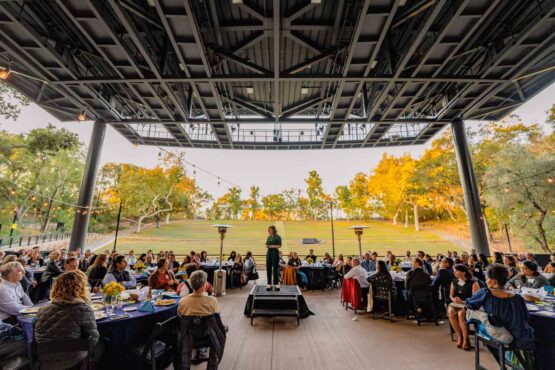

GROUNDBREAKING ASIAN AMERICAN ART INITIATIVE EXHIBITIONS
As the next phase in the Asian American Art Initiative that was established in 2021, the Cantor Arts Center presented dozens of new acquisitions in the groundbreaking fall exhibitions East of the Pacific: Making Histories of Asian American Art and At Home/On Stage: Asian American Representation in Photography and Film. With support from the Stanford Arts Incubator, Cantor staff collaborated with the Institute for Diversity in the Arts to commission the artist performance collective For You to create a series of original audio tours for East of the Pacific.
Image: From the exhibition At Home/On Stage, Michael Jang (American, b. 1951), Aunts and Uncles, 1973. Gelatin silver print on fiber-based paper. Cantor Arts Center, Stanford University. William Alden Campbell and Martha Campbell Art Acquisition Fund, 2020.13.2.
PROVOKING A SHIFT IN PERSPECTIVES ON U.S. HISTORY AND INCLUSION
Coinciding with the Asian American Art Initiative exhibitions and symposium, the Anderson Collection hosted a solo exhibition of works by artist, educator, and Stanford alum Stephanie Syjuco, MFA ’05, in the fall. In Stephanie Syjuco: White Balance/Color Cast, the artist utilized photography, video, installation, and social practice to interrogate the construction of American history and colonialism. Syjuco was the Artist Honoree at the 2022 Museums by Moonlight gala, and her work was also included in At Home/On Stage at the Cantor.
Image: Installation view of Stephanie Syjuco’s Block Out the Sun, 2021. Single-channel video with sound. Edition of 3 +2AP. Image credit: Courtesy of the artist, Catharine Clark Gallery, San Francisco, and RYAN LEE Gallery, New York. Photo by John Janca.
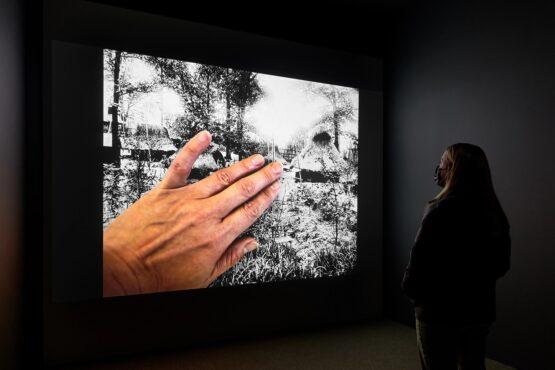
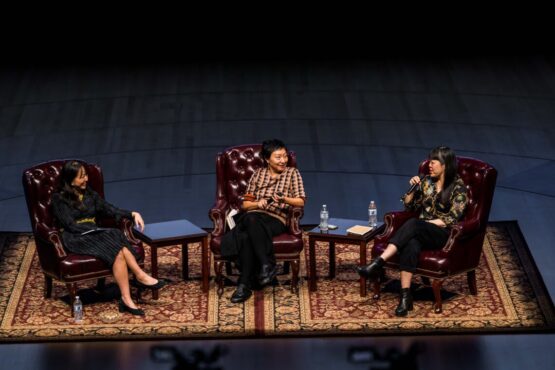
RETHINKING AND REIMAGINING THE HISTORIES AND FUTURES OF ARTISTS OF ASIAN DESCENT
The fall symposium IMU UR2: Art, Aesthetics, and Asian America, co-hosted by the Cantor Arts Center and the Department of Art and Art History as part of the Asian American Art Initiative, was one of the most significant gatherings ever held of scholars, curators, and artists committed to rethinking and reimagining the histories and futures of artists of Asian descent. The two-day convening culminated in a keynote conversation between author Cathy Park Hong and artist Jen Liu, moderated by Marci Kwon, Stanford assistant professor of art and art history and co-director of the Asian American Art Initiative (AAAI). The event also served as the public launch of the Martin Wong Catalogue Raisonné, a free online resource that is a collaboration between the AAAI, the Martin Wong Foundation, and Stanford Libraries.
Image: Marci Kwon, Cathy Park Hong, and Jen Liu (left to right) in conversation at the keynote event of the Asian American Art Initiative’s IMU UR2 symposium. Photo by Harrison Truong.
LEVERAGING THE POWER OF PERFORMANCE TO EVOKE EMPATHY AND SPUR ACTIVISM
The opera The Ritual of Breath Is the Rite to Resist and a series of related collective rituals staged across campus in October connected Stanford Live and the Department of Music with a community seeking justice and healing in the response to violence against Black people. The opera in seven movements was co-commissioned by Stanford Live and composed by Stanford’s Denning Family Provostial Professor Jonathan Berger. It was staged at Bing Concert Hall in October after a premiere at Hopkins Center for the Arts, Dartmouth College.
Image: Artwork from the opera that was born from a collaboration between Enrico Riley, a painter and Dartmouth professor of studio arts, and Jonathan Berger, a composer and professor of music at Stanford. The two engaged Vievee Francis, a poet, to craft the powerful libretto.
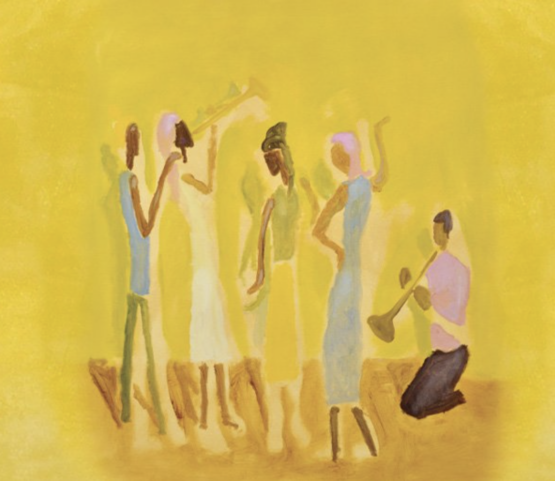
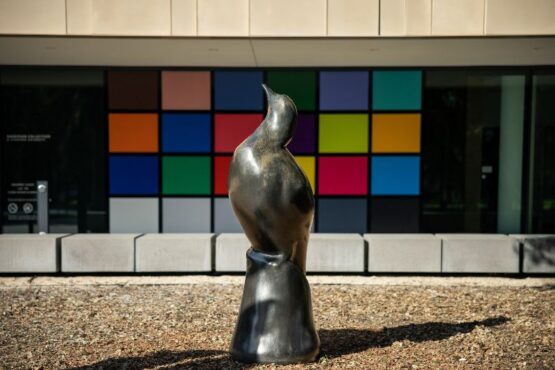
INSPIRING A CULTURAL SHIFT IN HOW HUMANS PERCEIVE OUR RELATIONSHIP TO THE ENVIRONMENT
As part of a thematic focus on sustainability and the environment, the Anderson Collection and Stanford Live presented Todd McGrain’s public art installation The Lost Bird Project. McGrain’s artwork was the inspiration for Stanford ’98 and MA ’99 alum Christopher Tin’s vocal composition The Lost Birds, which premiered at Bing Concert Hall in February. The five bronze sculptures that make up the art installation throughout the arts district represent North American birds driven to extinction. The sculptures can be found using an online map and are one of the self-guided tours offered as a new public art feature in the Stanford Mobile app.
Image: Todd McGrain’s Passenger Pigeon, driven to extinction 1900, n.d. Bronze. Courtesy of the Lost Bird Project and presented through the collaboration of Stanford Live, Anderson Collection at Stanford University, and Stanford Office of the Vice President for the Arts. Photo by Andrew Brodhead.
CONSIDERING ART AS A PROCESS OF INVENTION AND INQUIRY
In March, the Stanford Arts Institute presented the symposium Research and the Artistic (Im)Pulse to explore how – across diverse disciplines – artists’ ways of thinking and doing can inspire new modes of work and new kinds of research, with more direct engagement of public interest and more direct impact on pressing societal needs. The six internationally renowned artist presenters, all of whom engage in artistic practice in connection with research, critique, or activism, were Tanya Aguiñiga, Onyeka Igwe, Ken Liu, Rafael Lozano-Hemmer, Tavares Strachan, and Stanford visiting artist Anicka Yi.
Image: Poster for Research and the Artistic (Im)Pulse symposium, where six artists examined how art weaves together knowledge and imagination.
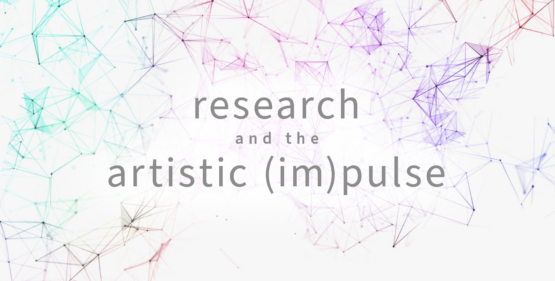
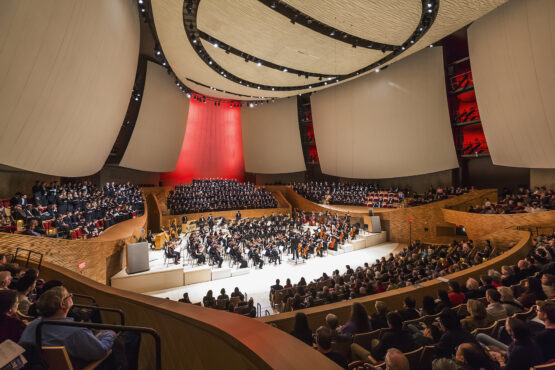
10TH ANNIVERSARY OF BING CONCERT HALL
On January 11, 2013, Bing Concert Hall was inaugurated as the new home for Stanford Live, launching a new era of performing arts for the community. Since then, Bing has welcomed such artists as Anna Deavere Smith, Yo-Yo Ma, and Kristin Chenoweth; hosted multiple world premieres (including many by Stanford composers); issued 10,236 student tickets; and attracted more than 286,000 people to its events. From its uniquely beautiful architectural elements to its acoustic flexibility, Bing is a key landmark in Stanford arts district, located at the gates of the campus.
Image: Bing Concert Hall exemplifies the seamless integration of architecture, acoustics, and technology to transform the performing arts’ practice, study, and experience. Photo by Jeff Goldberg.
LEARNING ABOUT POLITICS AND POWER FROM SHAKESPEARE’S JULIUS CAESAR
In March, for Stanford’s reimagined curriculum for first-year students, the play Julius Caesar – William Shakespeare’s tragedy about the assassination of the Roman leader and the violence that ensued – was staged as part of Citizenship in the 21st Century, the winter quarter course in Civic, Liberal, and Global Education (COLLEGE). The production – also open to the public – was the result of a new arts collaboration between COLLEGE and the Department of Theater and Performance Studies.
Image: Marlon Washington (left) as Marc Antony about to deliver his speech after Julius Caesar’s assassination. Photo courtesy of Stanford TAPS.


TRANSFORMING LIVES AND COMMUNITIES THROUGH EDUCATION
The course Transformative Art-Practices for Engaging Community was offered to students and the public by the Institute for Diversity in the Arts during the spring quarter. Students explored how artists address and transform issues central to communities of color, such as housing, healthy food access, abolition, human trafficking, land back, and cultural sovereignty. The explorations included visits from local and nationally recognized artists, activists, and scholars and site visits to surrounding communities to understand how cultivating relationships creates unprecedented conditions for collective healing and repair.
Image: Harmony House is the home of the Institute for Diversity in the Arts. Photo by Kate Chesley.
A NEW, ARTISTIC TAKE ON PLASTIC WASTE
Denning Visiting Artist Jean Shin’s yearlong artist residency modeled the expansive opportunities of interdisciplinary collaboration. Her site-specific repurposed plastic artworks built in the spring in the lobby of the Biomedical Innovations Building and in a public square in Kenya, as well as a related work installed on the façade of the Anderson Collection as part of the Convergence Zone exhibition, combined with the scientific expertise of pediatric infectious disease physician Desiree LaBeaud, highlighted the problem of plastic waste and challenged the global community to reimagine its relationship with plastics.
Image: Jean Shin’s Plastic Planet, 2023, installed in the Biomedical Innovations Building. Single-use plastic medical waste, zip ties, aluminum. Photo by Katie Han.
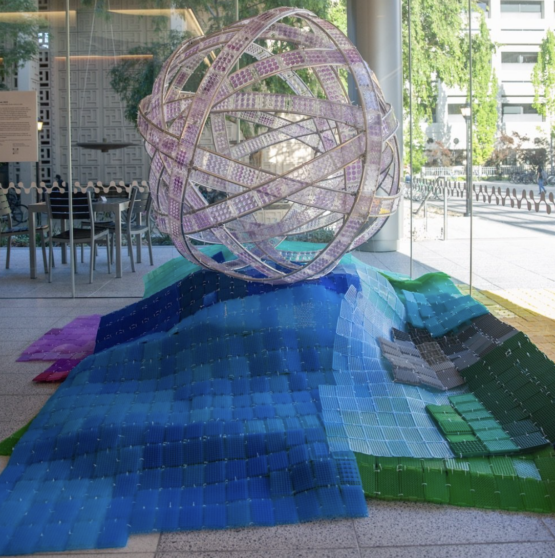
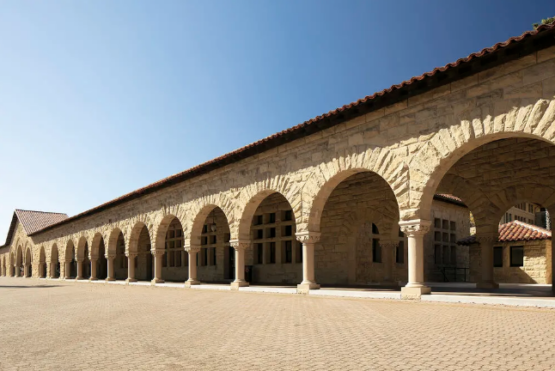
GROWTH MEETING DEMAND
The Creative Writing Program dramatically transformed in 2022-23 with several new appointments. Poet A. Van Jordan joined the faculty in the fall and taught an advanced poetry workshop to undergraduates during the winter quarter. The poet Amaud Jamaul Johnson joined the faculty in January and began teaching in the spring. Fiction writer Kirstin Valdez Quade and poet Aracelis Girmay arrived at Stanford over the summer.
Image: A teaching building where the Creative Writing Program welcomed the additional faculty because the demand for its courses regularly outpaces supply. Photo by Harrison Truong.
STANFORD ARTS ADVISORY COUNCIL 2022-23
Cynthia Lewis Beck ’77, JD ’80
Diana Bowes ’82
Sabrina Buell ’99
Louisa Cheng ’85
Michael Darling ’90
Katharine Duhamel ’83, MBA ’88
Melissa F. Fetter ’82 (ex officio)
Alex Fialho ’11
Doris Fisher ’53
Fred Harman ’82, MS ’83 (ex officio)
Leslie Hume MA ’71, PhD ’79
Mary Ittelson MBA ’85
Hiro Iwanaga ’04, MS ’04
Maryellie Johnson ’74, MBA ’76
Ronald Johnson ’80
Roberta Katz ’69
Carolyn Langelier
Luke Lorentzen ’15
Christy MacLear ’88
Deedee McMurtry
Wendy Munger ’72
Kitty Patterson ’75
Komal Shah MS ’93
V. Joy Simmons ’74
Vaughn Williams JD ’69, Chair
Ex-officio Faculty
Adam Banks, Faculty Director, Institute for Diversity in the Arts; Professor of Education, Graduate School of Education; Professor and Faculty Director, Program in Writing and Rhetoric
Jean Ma, Denning Family Director, Stanford Arts Institute; Professor of Art and Art History; Area Director, Film and Media Studies
Debra Satz, Vernon R. and Lysbeth Warren Anderson Dean of the School of Humanities and Sciences; Marta Sutton Weeks Professor of Ethics in Society; Professor of Philosophy and, by courtesy, of Political Science
Ex-officio Staff
Maude Brezinski, Executive Director, Development for the Arts
Deborah Cullinan, Vice President for the Arts
Trish Gerber, Associate Vice President, Development
A-lan Holt, Director, Institute for Diversity in the Arts
Jason Linetzky, Director, Anderson Collection
Chris Lorway, Director, Stanford Live*
Ellen Oh, Director, Interdisciplinary Arts Programs**
Veronica Roberts, John and Jill Freidenrich Director, Cantor Arts Center
Anne Shulock, Assistant Vice President for the Arts
*Chris Lorway left Stanford University in April 2023
**Ellen Oh was appointed Director of Interdisciplinary Arts Programs
in December 2022